Austrian performance artist, draughtsman, painter and film maker. He studied commercial graphic art at the Akademie für Angewandte Kunst in Vienna between 1957 and 1960. Following visits to Spain and the Venice Biennale of 1960, he started to paint gestural abstractions and came into contact with the Austrian painter Alfons Schilling (b 1934). In 1961 this development was interrupted when he was called up for military service, after which he found it difficult to return to painting, and by the end of 1962 he had started to concentrate on the act of painting rather than on the finished works themselves. He was persuaded by Otto Muehl to create, with his wife Anni, his first Aktion or performance, Ana, in November 1964, which he recorded on film in the first of a series of collaborations with the film maker Kurt Kren (b 1920). This led to his first self-painting Aktion, Self-painting 1: Painting by Hand, Painting by Head, Painting the Head, performed the following month. With Muehl, Hermann Nitsch and Rudolf Schwarzkogler he was a founder-member of the Aktionismus group, and with Muehl he helped found the Institut für Direkte Kunst in 1966. To an extent Brus conceived of his Aktionen in terms of paintings or tableaux, where the body occupied the centre of a clearly defined space; just as he had scratched and degraded the fabric of the paintings almost to destruction, in his Aktionen he portrayed various acts of self-mutilation. This development in Brus's work was encapsulated in the title of his exhibition in 1965 at the Galerie Junge Generation in Vienna, Malerei, Selbstbemalung, Selbstverstümmelung (Ger.: painting, self-painting, self-mutilation).
In 1966 Brus collaborated with Muehl on a number of performances. After 1967, however, Brus's Aktionen began to push him to further physical and mental extremes as he analysed his own body and its functions, whereas Muehl concentrated on the role of the body in the construction and analysis of psycho-dramas. All symbolism was dispensed with as Brus publicly urinated, defecated and cut himself with a razor-blade. The first of these Aktionen to be performed in public was Citizen Brus Looks at his Own Body, performed in Aachen and Düsseldorf in 1968, and in June of the same year his Art and Revolution, performed at Vienna University, led to his arrest and a six-month prison sentence for degrading the symbols of the State. The culmination of these body-analysis Aktionen came in 1970, when Brus stopped making live performances after Breaking Test (see fig.) was performed in West Berlin, where Brus had moved the previous year, after his work had been badly received and his life threatened in Austria. This was his most extreme Aktion and proved that the continuation of the theme of bodily self-analysis was no longer necessary or possible, since to try and continue realizing this in live actions would have exceeded his own physical limitations. Following this action he returned to painting, drawing and the production of artists' books. In 1971 he held his first exhibition of drawings at the Galerie Michael Werner in Cologne, while his book Irrwisch (1971) formed a link between the Aktion and the book form by containing the grotesque sexual humour and cathartic intention found in his actions. Many of his books from this period offered narrative depictions of his performances and fantasies. The bleak Expressionism of his Aktionen was, however, transformed in his later books into a more romantic form of Expressionism, often using the format of the fairy tale. In such books as Die Falter des Vorschlafs (1978) and Die Garten in der Exosphäre (1979) Brus revealed the similarity of intention between the sense of enchantment found in tales based on the theme of the ‘journey' and the liturgical mythology found particularly in the performances of Nitsch.Bibliography
Günter Brus: Zeichnungen und Schriften (exh. cat., text J. Gachnang and A. Meifert; Berne, Ksthalle, 1976)
Günter Brus: Bild-Dichtungen (exh. cat. by A. Meifert, London, Whitechapel A.G.; Hamburg, Kstver.; Lucerne, Kstmus.; Graz, Kulthaus; 1980–81)
Augensternstunden (exh. cat., foreword R. H. Fuchs; Eindhoven, Stedel. Van Abbemus., 1984)
H. Amanhauser and D. Ronte: Gunter Brus: Der Ãœberblick (Vienna, 1986).......................................................
.......................................................
.....................................
Artista, pintor y dibujante austriaco, miembro fundador y uno de los principales representantes del accionismo vienés. Nació el 27 de septiembre de 1938 en Ardning (Austria). Asistió a la Escuela de Artes y Oficios de Graz y a la Academia de Artes Aplicadas en Viena. En 1965 fundó junto con Hermann Nitsch, Otto Muehl y Rudolf Schwarzkogler el accionismo vienés. Sus acciones consistÃan en parte en exploraciones radicales de la propia corporeidad, en las que tanto su capacidad de intérprete como la capacidad de percepción de los espectadores eran sometidas a pruebas extremas. Por ejemplo, Zerreissprobe (Prueba de desgarro) representada en Munich en 1970 incluÃa automutilaciones. La acción Kunst + Revolution (Arte + Revolución) le valió en 1968, tras un proceso de investigación, una condena de varios meses, de la que se evadió huyendo con su familia a BerlÃn. Desde 1969 hasta 1979 vivió en BerlÃn, y a partir de entonces en Graz. Desde la década de 1970, ha centrado principalmente su actividad en la pintura y el dibujo. La obra de Günter Brus ha estado presente en numerosas exposiciones internacionales, como la Documenta V y VII de Kassel y las bienales de Venecia y Sidney. © eMe
..................................
...................................
..................................
.................................
I got my Myspace Layouts
from 123mycodes.com
